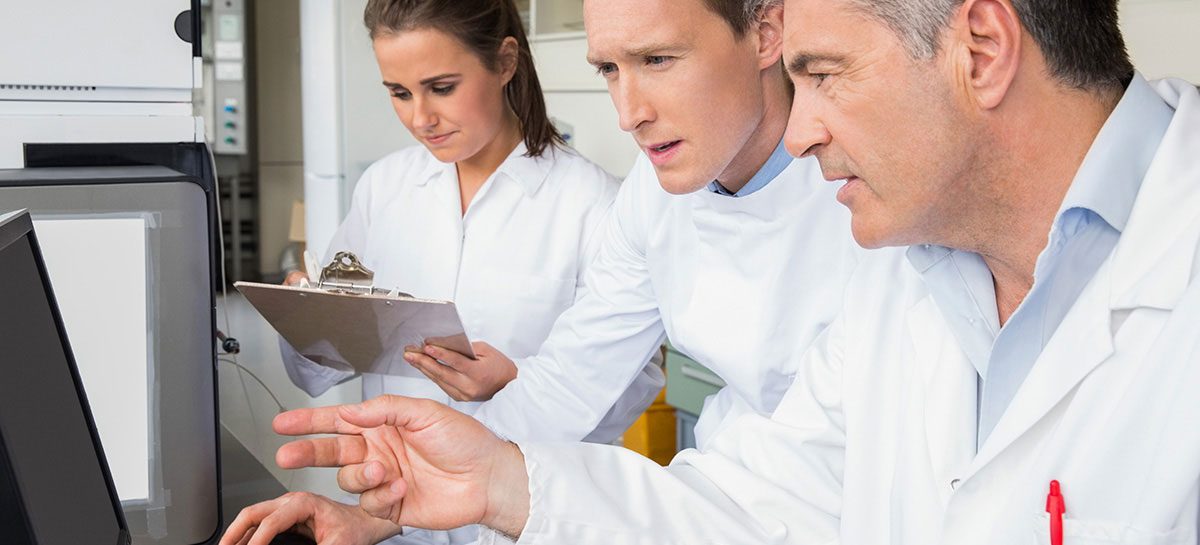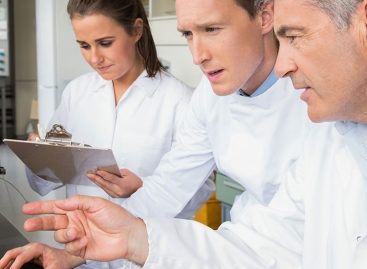Is it safe to conceive a child while taking Propecia? What about intercourse during pregnancy? Dr. Richard Lee opens up the clinical data and gives us the final word on the facts surrounding Propecia, Birth Defects, and having children… Not many things can surpass the stress caused by the possibility of causing birth defects in your own unborn child. So, it’s quite understandable that the mention of a possible birth defect with the use of finasteride (Propecia 1mg and Proscar 5mg, Merck) would cause considerable anxiety and concern. The package insert for Proscar states under the section on Contraindications: “Because of the ability of Type II 5alpha reductase inhibitors to inhibit the conversion of testosterone to DHT, finasteride may cause abnormalities of the external genitalia of a male fetus of a pregnant woman who receives finasteride”. So, is the risk real?
Theoretically, yes. Practically, no.
Birth Defects and Propecia
The specific birth defect they’re referring to, which happens when there is no Type II 5-alpha reductase enzyme in the male embryo, is called hypospadias. Hypospadias is a birth defect in which the urinary tract opening is developed on the ventral surface (under side) of the penis rather than at the tip of the penis. There have never been congenital abnormalities observed in female fetuses at any dosage of finasteride. During the research and development phase of finasteride, studies were done on experimental animals. Rats, rabbits, and rhesus monkeys were given finasteride to determine its relationship to birth defects, i.e. hypospadias.
Dr. Lee obtained his degree in medicine from the University of Pittsburgh, and has founded and operated one of the few private medical practices devoted entirely to the research and treatment of hair loss.. “Regrowth” was incorporated in 1987. Dr. Lee provides consultation services to hair loss sufferers, and has a line of custom minoxidil and topical spironolactone solutions which are widely used by our members here at HairlossTalk.com. Dr. Lee is a respected member of the HairlossTalk Community, and one of the few physicians truly educated on the causes and treatments of hair loss. You can see his website and products at minoxidil.com
– For more information on Topical Spironolactine, view our Topical Spironolactone Product Review For more information on Propecia, view our Propecia Product Review – Discuss Propecia with others: Antiandrogen Forums – Looking to buy Propecia online? Propecia Shop
Hypospadias did occur in the male offspring, when pregnant rats were administered doses that were between 5 and 5000 times the amount recommended for men in treating Male Pattern Baldness (1mg/daily). The critical period during which these effects can be induced in male rats was determined to be during the 16th and 17th days of gestation.
In rabbit fetuses which had finasteride directly injected into the uterus from days 6-18 of gestation at doses equivalent to 5000 times the recommended human dosage, no evidence of malformations was observed. This result would be expected, since there was no exposure during the critical period of genital system development in rabbits.
Conceiving a Baby While on Propecia
We have all seen the warnings about pregnant women being advised not to handle a broken propecia tablet. In many people’s minds, it stands to follow that if they shouldn’t handle a broken tablet, surely semen containing finasteride would be dangerous as well. Again, we should always look to the studies to get the facts we need. Scientists intravenously gave 750 times that dosage to Rhesus Monkeys. In fact it was 750 times the highest possible dose a woman could be exposed to through semen from a man taking 1mg per day. Even at this dose, there were no genital abnormalities observed.
Propecia and Genital Development during Pregnancy
In the human embryo, the period of external genitalia development is during the 7th – 9th weeks of gestation. Although the sperm (which can contain finasteride from the man taking Propecia) plays a role in determining the sex of the baby (either Y-bearing or X-bearing), the actual male and female morphological characteristics do not begin to develop until the seventh week of Pregnancy.
Prior to this time, the genital systems of the two sexes are similar, and the initial period of genital development is referred to as the ‘indifferent state of sexual development’. About six weeks after conception, if a Y chromosome is present in the embryo’s cells (as it is in normal males), a gene on the chromosome directs the undifferentiated gonads to become testes. If the Y chromosome is not present (as in normal females), the undifferentiated gonads will become ovaries. If the gonads become testes, they begin to produce androgens, primarily testosterone, by about eight weeks after conception. These androgens stimulate development of the one set of the genital ducts into the epididymes, vas deferens, and ejaculatory duct. The presence of androgens also stimulates development of the penis and the scrotum. Hypospadias can result if there is inadequate production of androgens by the fetal testes.
Since the sensitive period of development of the external genitalia in the human embryo is the 7th to 9th weeks of gestation, there can be no danger to the child if the father is taking finasteride at the time of conception. Originally, Merck decided to err on the side of caution and warned against the possible problem of finasteride transfer in semen. This warning has since been removed from the package insert. Considering the medical/legal implications of a theoretically possible link of finasteride treatment to birth defects, it is reasonable to assume that Merck & Co. must be very confident in knowing that impregnating a woman while taking finasteride absolutely does not cause birth defects.
Propecia & Intercourse During Pregnancy
Nor is there any evidence of birth defects when the father taking finasteride has intercourse with the pregnant mother during the critical periods of sexual development. The in utero effects of finasteride exposure during the period of embryonic and fetal development (gestation days 20-100) were evaluated in the rhesus monkey, a species fairly predictive of human development. Intravenous administration of finasteride to pregnant monkeys at doses as high as 800ng/day (at least 60 to 120 times the highest estimated exposure of pregnant women to finasteride from semen of men taking 5mg/day) caused no abnormalities in male fetuses.
Still, Merck retains this admonition: “Women should not handle crushed or broken Propecia tablets when they are pregnant or may be potentially pregnant because of the possibility of absorption of finasteride and the subsequent potential risk to a male fetus. Propecia tablets are coated and will prevent contact with the active ingredient during normal handling, provided that the tablets have not been broken or crushed.”
In Conclusion
Considering that intravenous administration of finasteride to pregnant experimental animals during the critical periods of sexual development didn’t cause birth defects, there is no reason to believe that transdermal absorption of finasteride from handling broken tablets could cause birth defects in the male child. But, since Propecia has not been approved by the FDA for use by women, Merck has nothing to lose by retaining this warning. In fact, it has good p.r. value.
So, can finasteride cause birth defects? Yes, there is a theoretical possibility that it can, but the probability is close to nil, when finasteride is taken in the recommended dosages. Since Propecia was approved by the FDA on 22 December 1997 and Proscar on 28 August 1996, millions of doses of finasteride have been taken and there has not been a single case report of a birth defect. Now that’s reassuring information.
Richard Lee, M.D.
Andersson, S.; Berman, D. M.; Jenkins, E. P.; Russell, D. W.: Deletion of steroid 5-alpha-reductase 2 gene in male pseudohermaphroditism. Nature 354: 159-161, 1991 Greene, S. A.; Symes, E.; Brook, C. G. D.: 5-Alpha-reductase deficiency causing male pseudohermaphroditism. Arch. Dis. Child. 53: 751-753, 1978 Imperato-McGinley, J.; Gautier, T.: Inherited 5-alpha-reductase deficiency in man. Trends Genet. 2: 130-133, 1986 Moore, KL and Persaud, TVN: Before We Are Born-Essentials of Embryology and Birth Defects; 6th Edition, Saunders 2003 New England J of Med: 1994, Jan 13; 330 (2) 120-5 Physicians Desk Reference, 58th Edition, 2004, pp. 2172-2178 Thigpen, A. E.; Davis, D. L.; Milatovich, A.; Mendonca, B. B.; Imperato-McGinley, J.; Griffin, J. E.; Francke, U.; Wilson, J. D.; Russell, D. W.: The molecular genetics of steroid 5-alpha-reductase 2 deficiency. J. Clin. Invest. 90: 799-809, 1992
About Article Author
Kevin Rands is the Founder of HairLossTalk.com and President of Online Health Networks, Inc. a Miami based corporation providing consumer health education on the web. He is also the Founder and Principal Writer for DisrupterDaily.com, an online publication on disruption of health and tech sectors.
View More Articles





i still dont get why on earth there’s no cure for baldness aside of this medicine which seems to have more side effects than benefits. i don’t get it.
It’s frustrating for sure. At the end of the day, hair loss is caused by male hormones, and male hormone receptors. Male hormones are a natural part of being male. So you either have to block the hormones, or block the receptors. There are topical androgen receptor blockers like S5 Cream and RU58841 which a lot of guys use to address hair loss concerns topically rather than internally.
Likewise, you don’t necessarily need to take a full 1mg dose of Finasteride to see the benefits. I think at the end of the day if you did a “before” test for DHT levels and tried 0.5mg with a subsequent “after” test to see a relatively noticeable drop in DHT levels, that might be a smart way of going about it. Not everyone needs the full dose. That’s just what was tested in the FDA trials.
In any case, look into “topical antiandrogens” if you want some ideas for options. As mentioned S5 Cream and S5 Plus Cream are two really popular ones right now.
thanks i’ll check it out. im already using finasteride gel and i dont see any sides right now. i has been 4 months already but in terms of regrowing i dont see that much
Finasteride (both oral and topical) is primarily a prevention / maintenance drug. It stops the cause of hair loss. Over 1 to 2 years, this means it can “allow” your hair to get back to growing properly again. Its a passive approach but a very effective one. Rogaine works amazingly well if you need to both stop hair loss and regrow hair quickly. I prefer the end-to-end approach though. Start with one thing, and give it 2-5 years before I add anything.
i did an hair transplant already, FUE. i was on finasteride an i lost my hair (those who were supposed to fall anyway) and i kept few of those transplanted. i stopped taking the drug and well, im back to the inititial situation in 4 months or so (a NW 5,im 28). i used minoxidil as well but it seems my sebum glands have a problem with it : my scalp became greasy and some hair went out squeezed with zits i never had before. Now that i am fully vegetarian from a couple of years and i avoid cheese and milk like the plague i feel better. Im wondering about taking finasteride both in pills and in the cream format to see if i can regrow something back
I’m a woman and I’m trying finasteride, minoxidyl, and also all kind of treatments possibles to hair loss. They are being injected in my scalp. The dosis seems to be really little.
Have I to avoid pregnancy?
Or if I’m pregnant (at the beginning), am I in trouble?
is there any problem if my husband is taking propecia and we are trying to conceive a baby?